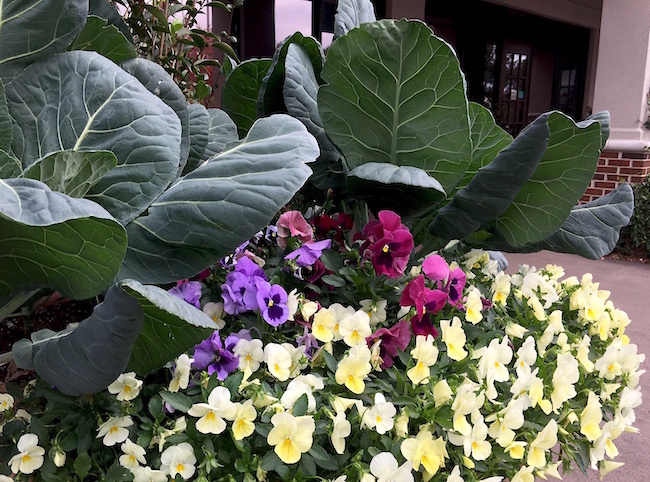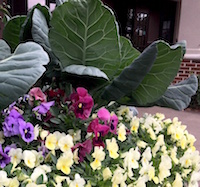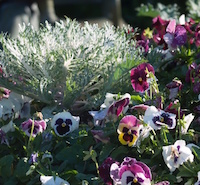The Brassicas are taking center stage! In the fall and winter seasons, we have always dabbled in flowering kale and cabbage, but it seems in the last couple of years that things are changing. The cruciferous crops are doing their part to create the wow factor in flower beds across Georgia. It’s not just flowering kale and cabbage on display, but edibles like the Toscano kale and – would you believe it – that old, Southern favorite, collards.
Last year anyone who went to the Savannah/Hilton Head International Airport could not help but notice the monolithic blue-green leaves serving as the backdrop to the pansies and snapdragons. The enormity of the leaves created their own photo-worthy moment. This year I am seeing collards used elegantly in mixed containers and even baskets. Why not? You couldn’t ask for a better companion to the colorful pansies. When I took the photo, I was thinking, “Now I need catfish and cornbread.”
While collards are really old fashioned, the application with ornamentals is new and trendy, at least in several generations. Toscano kale is also called “Toscana,” “Tuscan,” “lacinato” and “dinosaur kale.” Culinary experts know it is among the most flavorful and treasured in Italian soups and stews, but it’s recently new to the flower garden. You can rejoice at its incredible beauty and texture, but if you fancy yourself a chef, then it means an edible landscape is close at hand.
It may be after Thanksgiving, but the weather pattern looks very favorable to do some late-season gardening. So, if you have procrastinated like yours truly, then let the gardening festivities begin, and remember that these plants are among the easiest to grow. Prepare soil by incorporating 3 to 4 inches of organic matter and 2 pounds of a slow-release, 12-6-6 fertilizer per 100 square feet of bed space. Space them according to label recommendations – normally 12 to 18 inches apart. Add a good layer of mulch after planting to help stabilize soil temperatures and conserve moisture.
Kale, cabbage and mustards all need good drainage, but must remain moist and fed to keep them growing vigorously. Pay especially close attention as dry cold fronts have a tendency to deplete the available moisture. Feed them with light applications of the preplant fertilizer every four to six weeks. Leaf colors will intensify as the temperatures start to get cold.
Flowering kale, collards and mustards excel with beds of brightly colored pansies, violas, panolas and snapdragons. Don’t be afraid to cluster or mass-plant your kale – it will certainly create a visual thrill in the landscape. You can also plant bold drifts or sweeps of kale, collards or red mustards together. As you plan your bed, try planting a large bed of narcissus behind the kale, collards or mustards.
Kale or collards in containers might, at first, seem strange to you. Consider, however, that very same container during the summer probably had a variety of a dazzling coleuses, so why not carry on the thought or similar design with a cool-season foliage crop, fragrant dianthus and regular or trailing pansies.
The cool season is a wonderful time to garden, and foliage plants like kale, collards and mustards make the perfect pansy pals. It’s not too late – get in the garden this weekend. Follow me on Twitter @CGBGgardenguru and learn more about the University of Georgia Coastal Botanical Gardens at the Historic Bamboo Farm at www.coastalgeorgiabg.org.









